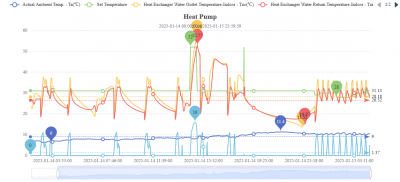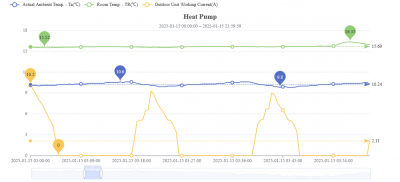I think this might be a different set of parameters for the user to interact with than the typical uk/european ones. That lower green line I commented on can't be power consumption as 12kW must be a measure of heat energy output not electrical input and the dotted line must represent average output over the period of the chart - the increase in average output as the average ambient temperature drops between the two charts seems to fit this.
What does your heat curve control? For most UK users the choice is between weather compensation setting the target temperature of the flow at different ambient temps, or for some like me with a Mitsubishi unit setting a target room temperature and allowing the algorithms to control the flow temps and running time depending on the actual room temp. Your setting of 31/32° only seem to match the average return temp. Now this might be quite a useful parameter as it will relate closely to the amount of heat delivered, the unit can then decide on the flow temp any given point to maintain the average.
From these two charts I would say you are unlikely to need continuous steady state running much above 3 or 4°. Cycling occurs because the pump is generating more heat than it needs to deliver - asking it to generate more might increase the length of the 'off' periods but at the expense of the efficiency of the on periods. The option most people use is to have setbacks in target temperature which effectively turn the heat off for a while, condensing these off periods together by restricting the time period over which the day's total heat requirement is spread.
Mitsubishi EcoDan 8.5 kW ASHP - radiators on a single loop
210l Mitsubishi solar tank
Solar thermal
3.94kW of PV
Posted by: @ivanhoewyes! that is 11.3 kw !! ...scary,and depressing ,i just assumed that's how they all work .
@ivanhoew - just a couple of points I don't think have been picked up yet. As you mentioned in your earlier post, the green line is Amps, not kW, so a 11.3 reading is 11.3A, that's (at 240V) 2.7kW, which is a perfectly reasonable power for a heat pump working in these temperatures. If it were 11.3kW the current would be 47A (this is a huge domestic load).
Secondly, in your graphs, the dotted line ending in an arrow on the right appears to be an average value for the curve on the graph. In that case, the upper graph (the one with the 11.3 marker) has an average value of 3.51A, which, at 240V, is an average power (assuming a power factor of 1) of 842W. Over 24 hours, this is leads to a consumption of 20.2kWh, which ties in with (at least) your consumption on 12th Jan.
Posted by: @ivanhoewits hard to work out which setting uses least power ,but then i am a total newbie.
All things being equal (e.g. outside temperature) this average current (Amps) value then gives you the comparison you're after. If you're after cost, then multiply this average value by 240*rate to give an hourly average operating cost.
End 1980's terrace in Southern England
NIBE 12kW air source heat pump
2 solar water panels
1 x Ohme ePod
1 x VW ID Buzz
Posted by: @s_gatoratorPosted by: @ivanhoewyes! that is 11.3 kw !! ...scary,and depressing ,i just assumed that's how they all work .
@ivanhoew - just a couple of points I don't think have been picked up yet. As you mentioned in your earlier post, the green line is Amps, not kW, so a 11.3 reading is 11.3A, that's (at 240V) 2.7kW, which is a perfectly reasonable power for a heat pump working in these temperatures. If it were 11.3kW the current would be 47A (this is a huge domestic load).
Secondly, in your graphs, the dotted line ending in an arrow on the right appears to be an average value for the curve on the graph. In that case, the upper graph (the one with the 11.3 marker) has an average value of 3.51A, which, at 240V, is an average power (assuming a power factor of 1) of 842W. Over 24 hours, this is leads to a consumption of 20.2kWh, which ties in with (at least) your consumption on 12th Jan.
Posted by: @ivanhoewits hard to work out which setting uses least power ,but then i am a total newbie.
All things being equal (e.g. outside temperature) this average current (Amps) value then gives you the comparison you're after. If you're after cost, then multiply this average value by 240*rate to give an hourly average operating cost.
Thank you s-gatorator ,
i.am.such.a.numpty !
i even put amps at the graph post !!
re this bit ..
''multiply this average value by 240*rate''
do you mean average amps x 240 x my rate in pence per kw for that time period ?
Edit: i realise its 240v . so amps x volts +watts ... do i then go for /1000 to get kw ?
.....( amps x 240 / 1000 ) x rate in pence per kw .
regards
robert
Posted by: @harriupI think this might be a different set of parameters for the user to interact with than the typical uk/european ones. That lower green line I commented on can't be power consumption as 12kW must be a measure of heat energy output not electrical input and the dotted line must represent average output over the period of the chart - the increase in average output as the average ambient temperature drops between the two charts seems to fit this.
What does your heat curve control? For most UK users the choice is between weather compensation setting the target temperature of the flow at different ambient temps, or for some like me with a Mitsubishi unit setting a target room temperature and allowing the algorithms to control the flow temps and running time depending on the actual room temp. Your setting of 31/32° only seem to match the average return temp. Now this might be quite a useful parameter as it will relate closely to the amount of heat delivered, the unit can then decide on the flow temp any given point to maintain the average.
From these two charts I would say you are unlikely to need continuous steady state running much above 3 or 4°. Cycling occurs because the pump is generating more heat than it needs to deliver - asking it to generate more might increase the length of the 'off' periods but at the expense of the efficiency of the on periods. The option most people use is to have setbacks in target temperature which effectively turn the heat off for a while, condensing these off periods together by restricting the time period over which the day's total heat requirement is spread.
As s-g has drawn to my limited brain cells attention , its actually amps not kw HarriUp .doh.
RE my heat curve/ weather compensation , to set it you chose 5 different ambient temperatures , which i have scaled from -3 to 20c i think , then ,for each of those amb temps you can choose a water flow temp .
so do you think that , say its at 29c FT , and cycling 2 times an hour , is more eff than flow temp of 34c , and cycling once an hour ?
i ws pondering whether only running at once an hour , it would only have that 11 amp spike once instead of twice , even though its less eff , its doing that spike only once . if that makes some sort of convoluted sense !
regards
robert
Posted by: @ivanhoewEdit: i realise its 240v . so amps x volts +watts ... do i then go for /1000 to get kw ?
Hi @ivanhoew , no worries. This is such a well-informing and helpful forum that one well-meaning but self-answerable query is quite likely of use to others, so glad to be of help.
Yes, divide by 1000 to get from Watts to kiloWatts
Posted by: @ivanhoew....( amps x 240 / 1000 ) x rate in pence per kW .
Yes, I was not clear about the rate. Properly, it's ( amps x 240 / 1000 ) x rate in pence per kWh to give running cost per hour.
End 1980's terrace in Southern England
NIBE 12kW air source heat pump
2 solar water panels
1 x Ohme ePod
1 x VW ID Buzz
i thought this was quite interesting ,
two very different wave forms ,
the area to the left of the hot water demand is set at 15c overnight , and 31c flow temp .the thermostat in the hall switching it on and off .
Then the area to the right of the hot water , is with the hall thermostat set high so it wont work , then water temp experimented from 28c to 30 c , and the Ft " switch back on" hysteresis changed from 3c to 2c . this gave a 20 minute cycling ...also the FT Delta changed and became a couple of degrees larger .
house reached 16.3c in the hall set at 30c FT .
using the energy stats app i found i can see that the energy used each hour for the last 4 hours was 0.7kw .
the graph above ended at 8.21 pm today .
regards
robert
Posted by: @ivanhoew
As s-g has drawn to my limited brain cells attention , its actually amps not kw HarriUp .doh.
RE my heat curve/ weather compensation , to set it you chose 5 different ambient temperatures , which i have scaled from -3 to 20c i think , then ,for each of those amb temps you can choose a water flow temp .
so do you think that , say its at 29c FT , and cycling 2 times an hour , is more eff than flow temp of 34c , and cycling once an hour ?
i ws pondering whether only running at once an hour , it would only have that 11 amp spike once instead of twice , even though its less eff , its doing that spike only once . if that makes some sort of convoluted sense !
Amps - yes, you did say. Not the most useful measure to have graphed though!
To your examples:
Lets say 34 is the temperature at which the radiators to drop the right amount of heat to maintain the desired room temp – but not drop enough to lower the return to balance the HP, then the flow temp will creep up gradually and the HP will have to stop for a while to allow the heat to transfer.
If you lower the flow temp then your radiators output also drops significantly, making any discrepency to the heat generated at the pump even wider so the flow temp rises quickly and pump stops sooner. This can occur several times an hour - hence the term short cycling. The double whammy is that not only is it inefficient for the heat it does generate, but the frequent stops means not enough heat gets transferred to keep your house at the desired temperature.
Spells of weather when it remains overcast and the temperature doesn't fluctuate too much over the day are good periods to try different strategies, otherwise so many other variables are changing it is hard to pinpoint causes and effects.
Mitsubishi EcoDan 8.5 kW ASHP - radiators on a single loop
210l Mitsubishi solar tank
Solar thermal
3.94kW of PV
Posted by: @harriupSpells of weather when it remains overcast and the temperature doesn't fluctuate too much over the day are good periods to try different strategies, otherwise so many other variables are changing it is hard to pinpoint causes and effects.
I agree, and in at least some of the UK we are likely to see such conditions over the next few days.
@ivanhoew - I am becoming unsure about what you want to achieve! If it is steady heating at reasonable cost, with or without a setback say overnight, then usually the best starting point is open loop (everything as open as can be), room stat set high (say 28 degrees - you use it as an on/off switch, not as a temperature control) and use weather compensation to manage the indoor air temperature. The is a trial and error process, start with the weather compensation curve set to something that seems reasonable, then tweak to get closer to your desired indoor air temperature. This will also may it easier to interpret your chart, less variables changing. Once you have got a weather compensation curve set up, you can experiment with setbacks, done by setting the room start very low, ie you are using it as an on/off switch, not a thermostat. How much money you save using a setback is a very moot point, it is not as simple as you just save what you save while the heating is off. Plenty of discussion on this in the forum.
The chart: I am not sure how you get, store and plot the data, or how frequent the sampling is, ie how reliable it is. It would also be very useful to have indoor air temperature on the chart. Can I also suggest readability could be improved by setting the X axis to UK clock time and having tick marks on hour points and remove seconds, also make legend labels more concise (Set temperature? What set temperature? plus remove redundant words so more labels can be seen), and remove both popup readings and the -o- markers, they get in the way. Just suggestions, at the end of the day it is your chart!
Midea 14kW (for now...) ASHP heating both building and DHW
thank you CathodeRay ,
Unfortunately the chart is as it comes , i can add or remove data streams ,and change the x axis length . i have asked the uk rep if he can fix the bse line time scale .
what i am trying to achive is , given two scenarios , as HarriUp , has nicely summed up , find which one is most efficient .
Scenario 1 , is , i set the flow temp to, say , 33c , the heating then cycles ,say, once an hour , the intial amps spike is higher ,but it only happens once in that hour .a certain amount of kw is used , and the hs attains the correct temp quicker .however , the temp diff between ambient and my demanded temp is greater , so cop reduces ..presumably...
scenario 2 is , i set it to 29c FT , the cycling increaes to ,say, every 20 minutes , however the amps draw is less , and the cop is better due to the smaller diference between ambient and demanded FT . house heats up more slowly .so i have more cycles and a bit less draw per cycle .
now that i have the excellent suggestion about observing the average amps , and calculating from that , i did a test yesterday, where , according to my smart meter , i drew 0.7 kw in the 7-8 pm hour , and from my HP datalog , i could see i was averaging 2.11 amps ...
2.11 x 240 =506 w or .506 kw .
knowing my other hs loads were in the region of 240w , i could then add that .. .0.506 kw + 0.240 kw = 0.746 kw , which equates well with the smart meter /energy stats data .
next thing is to find a steady state period of temps and wind and nicely overcast , and try both scenarios , and monitor the energy usage .
what i have learnt so far ,
Ideally my pump size would be designed to create steady state operation , and minimum cycling,avoiding start ups .
my system appears to be a bit big , and so cycling is a given .
the rate of this is variable , using different FT and house temps , and external conditions ...particularly wind which blows strongly here , and no matter what FT works well with still conditions , needs a couple more degrees if it's high wind chill out there .
i also recognise my hs temps i am using , are well below the norm .
my initial concerns regarding cycling ,and a frequency of perhaps every 20 minutes , have been assuaged , and i feel better about experimenting , with less concern about burning out my pump with such a degree of on and offness.
research continues !
regards
robert
Posted by: @ivanhoewUnfortunately the chart is as it comes , i can add or remove data streams ,and change the x axis length . i have asked the uk rep if he can fix the bse line time scale .
I think this probably means it is on a server somewhere in China. It looks like very detailed data with very frequent data sampling, possibly every minute, but that is a huge amount of data to be shunting round the world. From the chart you posted posted recently, covering one hour, it seems possible the sample rate may be every 10 minutes (x6/hour) based on the -o- markers. If so, how do they get the apparently near continuous amps data, which suggests much more frequent sampling?
Very useful to have room temp on the chart now.
Going back to basics, why not try using weather compensation rather than fixed flow temps? WC should mean the lowest possible flow temp consistent with your chosen desired room temp, and thereby all other things being equal best performance? You can then observe the cycling behaviour at various OATs, and consider, what, if anything, can be done to improve things.
Can you get at the actual data behind the plots? A download option? If you can, there might be very useful information hidden there. If there isn't an explicit download option, there are ways to sniff out the data, but they are not always straightforward.
Midea 14kW (for now...) ASHP heating both building and DHW
Sampling rate is every 30 seconds ray , if i zoom in i can see that rate .
i probably have not explained myself vey well , i have been using weather compensation all the time , i am just using a fixed weather state to try to compare eff.
yes the data can be downlaoded to excel , i am hoping to use this to calulatec my cop .
regards
robert
- 26 Forums
- 2,356 Topics
- 53.4 K Posts
- 449 Online
- 6,017 Members
Join Us!
Worth Watching
Latest Posts
-
RE: Octopus Cosy Heat Pump Owners & Discussion Thread
@kevh It's something I'm trialling at the moment - I've...
By AndrewJ , 3 minutes ago
-
RE: Electricity price predictions
Ben Watts posted on LinkedIn that he had updated this w...
By Judith , 4 hours ago
-

RE: The good, the bad and the not that great – my heat pump installation
Small update, Emailed and Spoke to Midea UK and they ...
By Burtis , 4 hours ago
-
RE: Solis S6-EH1P8K-L-PLUS – Why I Chose It and What I’ve Learned So Far
@bash Octopus does charge for the admin. The process al...
By Batpred , 4 hours ago
-
RE: External pipework insulation
@transparent HI all The products you mention are ver...
By David Smith , 4 hours ago
-
RE: New Fogstar 15.5kWh upright solution
Issues still under investigation by Solis... Fogstar ...
By Batpred , 4 hours ago
-
RE: Who's your electricity provider and what's your tariff?
I agree, the consumer is not being properly represented...
By Batpred , 4 hours ago
-

RE: Controlling Daikin Altherma via P1P2 and Home Assistant
@weoleyric, apologies for the delay in response. Give...
By Majordennisbloodnok , 6 hours ago
-
RE: Advice on internal circulation pump noise
Thanks @mikefl - I'll maybe have a look at the lock-shi...
By jtg , 21 hours ago
-

RE: Heat Pump Heats the House… But It’s Not Cosy. Emitter Changes or System Tweak?
@toodles interesting suggestion, thanks. I will try to...
By GrahamF , 22 hours ago
-
RE: Mitsubishi Ecodan Auto Adaption trial to stop cycling.
The interval you talk of, i think, will be 60min for an...
By F1p , 1 day ago
-
Agree with @majordennisbloodnok on the setbacks. We hav...
By ChandyKris , 2 days ago
-

RE: Speedcomfort radiator fans
@deltona the way the links were added broke the page. A...
By Mars , 2 days ago
-

RE: Setback savings - fact or fiction?
I agree! Even more so if we get an answer! But the chal...
By cathodeRay , 2 days ago
-

RE: Refrigerant R32, is it now banned in the EU from 1st Jan 2027 for monobloc ASHPs?
This has been delayed from what I believe to be this ye...
By dgclimatecontrol , 2 days ago
-
RE: Are We Sleepwalking Into Another Race to the Bottom?
this is why I provided current flow temperatures in the...
By ksim , 2 days ago
-

RE: Why Millions of UK Homes Struggle With Heat Pumps
There's many homes that would be quite a disruption for...
By dgclimatecontrol , 2 days ago
-
RE: Ecodan unable to hit legionella target temp - what's the consensus?
@rhh2348 ...maybe this option is what you want? Alter...
By benson , 2 days ago
-

RE: Free Ecoheat Heat Pump Install
@old_scientist This does make the unit smaller as the b...
By dgclimatecontrol , 2 days ago






